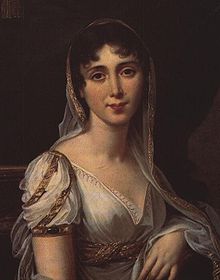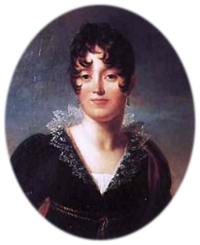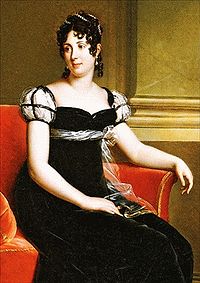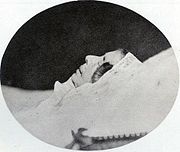- Désirée Clary
-
Désirée Clary 
An early portrait by Robert Lefèvre Queen consort of Sweden and Norway Tenure 5 February 1818 – 8 March 1844 Coronation 21 August 1829 Spouse Charles XIV John of Sweden Issue Oscar I of Sweden Full name Bernardine Eugénie Désirée Father François Clary Mother Françoise Rose Somis Born 8 November 1777
Marseille, FranceDied 17 December 1860 (aged 83)
Stockholm, SwedenBurial Riddarholmen Church Religion Roman Catholic  Désirée Clary by François Gérard (1810)
Désirée Clary by François Gérard (1810)
 As Crown Princess of Sweden, wearing the Nationella dräkten, by R Lefévre.
As Crown Princess of Sweden, wearing the Nationella dräkten, by R Lefévre.
Bernardine Eugénie Désirée Clary (8 November 1777 – 17 December 1860), one-time fiancée of Napoleon Bonaparte, was a Frenchwoman who became Queen of Sweden and Norway as the consort of King Charles XIV John, a former French General. She officially changed her name there to Desideria, a Latin version of her original name.[1] Désirée herself, however, did not like the name Desideria and never used it.[2]
Contents
Early life and family
Désirée Clary was born in Marseille, France, the daughter of François Clary (Marseille, St. Ferreol, 24 February 1725 – Marseille, 20 January 1794), a wealthy silk manufacturer and merchant, and his second wife (m. 26 June 1759) Françoise Rose Somis (Marseille, St. Ferreol, 30 August 1737 – Paris, 28 January 1815). He had been previously married at Marseille, 13 April 1751 to Gabrielle Fléchon (1732 – 3 May 1758), without issue. Her sister, Julie Clary, married Joseph Bonaparte, and later became Queen of Naples and Spain. Her brother, Nicholas Joseph Clary, was created 1st Count Clary and married Anne Jeanne Rouyer, by whom he had Zénaïde Françoise Clary (Paris, 25 November 1812 – Paris, 27 April 1884), wife of Napoléon Berthier de Wagram, 2nd duc de Wagram (10 September 1810 – 10 February 1887), son of Marshal Berthier, and had issue.
Désirée received the convent schooling usually given to daughters of the upper classes in pre-revolutionary France, but, during the Revolution of 1789, convents were closed[3] and Désirée returned to live with her parents. Her education was described as shallow.[4] She was to be very devoted to her birth-family her entire life. In 1794, her father died. Her brother was arrested by the revolutionary government, and she was later to say that he was released by Joseph Bonaparte on her intervention, after which Joseph was presented to her family and married her sister. Désirée was presented to Napoleon Bonaparte, to whom she became engaged on 21 April 1795; but upon becoming involved with Joséphine de Beauharnais, whom he married on 9 March 1796, Bonaparte broke off his engagement with Désirée.
In 1795–1797, Désirée lived with her mother in Genoa in Italy. In 1797, she went to live with her sister Julie and her brother-in-law Joseph, who was the French ambassador to Rome. Her relationship with Julie was always to be very intense and deep. She was briefly expected to marry the French General Léonard Duphot,[5] but he was killed in a riot in Rome in December 1797, on the eve of their marriage.
Madame Bernadotte
After her return to France, she met her future husband, the French General Jean Baptiste Jules Bernadotte. They were married at Sceaux on 17 August 1798. In the marriage contract, Désirée was given economic independence.[6] In 1799, she gave birth to their only child, a son, Oscar, but the couple lived more or less separate lives afterward.
Her husband was a leading general in the French Napoleonic army, and normally absent from Paris. Désirée had a good relationship with the Bonaparte Imperial family, as well as with the Empress Joséphine, and declined taking sides in the conflicts between Joséphine and the Bonaparte siblings. She had a place in the coronation ceremony in 1804. Désirée lived a comfortable social life in Paris during her husband's long absences, though she preferred an informal family life to that of the Imperial court. It is believed that she may have had a romantic relationship with the Corsican Ange Chaippe, who often acted as her escort.[7] In 1804–1805, Bernadotte was made governor of Hanover, and Désirée and her son moved to Hamburg; but she soon returned to Paris. She was not happy living anywhere but Paris. When her spouse was made Prince of Pontecorvo in 1806, Désirée worriedly asked if she would be forced to leave Paris, but was happy when she was assured that she would not.[8] In 1807, she visited Bernadotte in Spandau.
Désirée was not interested in politics, but her good connections made her a puppet in the hands of her husband and Napoleon, who both used her to influence the other and to communicate with each other with her as a messenger.[9]
In 1810, Bernadotte was elected heir to the throne of Sweden. Désirée initially thought this was to be similar to the position of Prince of Pontecorvo, and was depressed when she found out that this time she was expected to leave Paris.
Crown Princess
Désirée visited Sweden for the first time in 1810 but could not adapt to the demands of formal court etiquette. She was said to have been treated with a certain snobbery by the court and especially the Queen, though the Dowager Queen was kind to her. The climate was also a shock; she arrived during the winter, and she hated the snow so much that she cried.[10] She had never wished to be a queen and did not want to move so far away from her family. The queen found her spoiled and undignified, and Désirée's French entourage, especially Elise la Flotte, made her unpopular by encouraging her to complain about everything.[11] The Queen described her as good-hearted, generous and pleasant when she chose to be and not one to plot, but also as immature and a "spoiled child",[12] who hated all demands and was unable to handle any form of representation.[13] She described Desiree as "a French woman in every inch," who disliked and complained about everything which was not French, and "consequently, she is not liked."[14]
She left Sweden in 1811 under the name of "Countess of Gotland", officially because of her health, and returned to Paris. There she stayed for twelve years, leaving her husband and her son behind. She herself said that the Swedish nobility had treated her as if they were made of ice: "Do not talk with me of Stockholm, I get a cold as soon as I hear the word."[15] She resided incognito in Paris, thereby avoiding politics during the difficult period when Sweden was at war with France. However, her house at rue d'Anjou was watched by the secret police, and her letters were read by them. When Napoleon was defeated in 1814, her house was a refuge for her sister Julie. Bernadotte met her in Paris, but returned to Sweden without her. She was ridiculed by the court of Louis XVIII of France as an upstart, but had her own little court where she held receptions. In 1816, she made plans to return to Sweden, but she wished to bring her sister, Julie; her husband thought this unwise, as Julie was a member of the Bonaparte family and her presence might be taken as a sign that he sided with the deposed Napoleon, and in the end, this came to nothing.[16]
Désirée's husband had employed a Count de Montrichard at her household (1817) as his spy to report to him if she did anything which could affect him.[17]
Queen
In 1818, her husband became king of Sweden; but she remained in Paris, officially for health reasons, which was discussed in the papers in Paris and by her visitors. In Sweden, her husband took a mistress, the noble Mariana Koskull. Désirée held receptions in Paris as the queen of Sweden on Thursdays and Sundays, though she still used the title of countess. She fell in love with the French minister, the duc de Richelieu, and followed him on his travels until his death in 1822.[18] In 1822, she met her son in Aachen.
In 1823, Désirée returned to Sweden together with her son's bride, Josephine of Leuchtenberg; the visit was initially to be but a short one. On 21 August 1829, she was crowned Queen at her own request. She also talked about a coronation in Norway, but the Norwegians found it impossible because of her religion. She was, in fact, not religious, but was forced to attend mass and confession by her daughter-in-law.[19] She was the first commoner to be a queen since Karin Månsdotter in 1568. The 1830s were a period when she did her best to be active as a queen, a role she had never wanted to play. The decade is described as a time of balls and parties, more than had been seen at the Swedish court since the days of King Gustav III, but Désirée soon grew tired of her royal status and wanted to return to France. However, her husband did not allow it.
There is nothing to indicate that she ever had any political influence. She spent her summers at Rosersberg Palace, and often visited Swedish spas, such as Ramlösa spa. She visited Norway a couple of times, the first time in 1825.[20] The court was astonished by her informal behaviour. Every morning, she visited her husband in her nightgown, which was seen as shocking, because her husband usually conferred with members of the council of state in his bed chamber at that time. Otherwise, they met only on formal occasions: because she was always late at dinner, he stopped having his meals with her after 1826: and as her consort also preferred to have his meals alone, it was not uncommon for the nobles of the court to sit alone at the dinner table, without the royal couple present.[21] She went to bed late, and woke up late.
She never became very popular at the royal court and never learned to speak Swedish, and there are many anecdotes of her attempts to speak the language. She kept her French personal staff: during the first years, her niece, countess Marcelle Tascher de la Pagerie, was her lady-in-waiting. Among her other more known ladies-in-waiting were the Norwegians Kathinka Falbe and Jana Falbe; because of Desiree's eccentric habits, they were known as "Strapatsfröknarna" (approximately "Mlles. Calamity").[22] During her stays at Rosersberg Palace, she took walks in the parc by night, and as she had a fear of being attacked by bats, she instructed her ladies-in-waiting to walk in front of her dressed in white to attract the bats from her.[23]
Queen Dowager
In 1844, her husband died. In 1853, she wished to return to Paris, but her fear of sea travel made it impossible. After becoming a widow, she grew more and more eccentric. She went to bed in the morning, got up in the evening, ate breakfast at night, and drove around in a carriage through the streets, in the courtyard, or wandered around the corridors of the sleeping castle with a light.[24] An anecdote illustrates this: in 1843, a palace guard saw the queen fully dressed on the palace balcony in the middle of the night. When he came home to his wife, he told her that she was lazy in comparison to the queen, who had gotten up hours before sunrise.[25] He thought Queen Désirée was up earlier than anyone else in town, but in fact, she had not yet gone to bed-–she would eventually get up from bed at three or four in the afternoon. She enjoyed making unannounced visits, and sometimes she would take in children from the streets to the palace and give them sweets; she was not able to engage in any real conversation, but she would say "Kom, kom!", which is Swedish for "Come come!"[26]
There are other stories about people having been awakened by her carriage when she drove through the streets at night; the carriage sometimes stopped. She would sleep for a while, and then she would wake and the carriage would continue on its way. Sometimes she drove in circles around the royal palace: this habit was called "Kring Kring", one of the few Swedish words she learned, which means "around and around".[27] On the last day of her life, she entered her box at the Royal Swedish Opera just after the performance had ended. Désirée died in Stockholm on 17 December 1860.
Ancestry
Her paternal grandparents were Joseph Clary (Marseille, 22 November 1693 – Marseille, 30 August 1748), son of Jacques Clary and his wife Catherine Barosse, paternal grandson of Antoine Clary and wife Marguerite Canolle, and maternal grandson of Angelin Barosse and his wife Jeanne Pélissière, and wife (m. in Marseille, 27 February 1724) Françoise-Agnès Ammoric (Marseille, 6 March 1705 – Marseille, 21 December 1776), daughter of François Ammoric and his wife Jeanne Boisson.
Her maternal grandparents were Joseph Ignace Somis (c. 1710 – Marseille, 29 April 1750), son of Jean Louis Somis and his wife Françoise Bouchard, and wife (m. in Marseille, 27 May 1736) Catherine Rose Soucheiron (Marseille, 11 January 1696 – Marseille, 18 February 1776), daughter of François Soucheiron and his wife Anne Cautier.
16. Antoine Clary 8. Jacques Clary 17. Marguerite Canolle 4. Joseph Clary 18. Angelin Barosse 9. Catherine Barosse 19. Jeanne Pélissière 2. François Clary 20. 10. François Ammoric 21. 5. Françoise-Agnès Ammoric 22. 11. Jeanne Boisson 23. 1. Désirée Clary 24. 12. Jean Louis Somis 25. 6. Joseph Ignace Somis 26. 13. Françoise Bouchard 27. 3. Françoise Rose Somis 28. 14. François Soucheiron 29. 7. Catherine Rose Soucheiron 30. 15. Anne Cautier 31. Désirée Clary in fiction
Désirée Clary is the subject of a popular novel, a mock autobiography by Annemarie Selinko, Désirée, 1951; and of two films:
- Le Destin fabuleux de Désirée Clary (1942) a French film made by Sacha Guitry
- Désirée (1954), an American film based on Selinko's book, with Jean Simmons and Marlon Brando
- The Selinko book mentioned above was originally published in 1951 in German, by Kiepenheuer & Witsch, and quickly rose to the best-seller lists around the world. It has been translated into many languages, including English, French, Spanish, Turkish, Greek, and Chinese.
Clary and Marie Tascher, better known as Joséphine de Beauharnais, the future wife of Napoleon and first empress of France, were also the subjects of a screen treatment written by John B. Langan and published in 1918, The Bernadotte Album, which purported to be "Founded on the memoirs of Marie Tascher and Désirée Clary."
Notes
- ^ http://www.babynamespedia.com/meaning/Desideria
- ^ Lars Elgklou (1995) (in Swedish). Familjen Bernadotte. En släktkrönika. (The Bernadotte family. A family chronicle.). Skogs Boktryckeri Trelleborg. ISBN 91 7054 7556.
- ^ http://books.google.com/books?id=3v0aAAAAYAAJ&pg=RA1-PA751&lpg=RA1-PA751&dq=le+fr%C3%A8re+de+D%C3%A9sir%C3%A9e+Clary+arr%C3%AAt%C3%A9+en+1794&source=bl&ots=Fo5YRkBm4t&sig=-fwWxCjxaO5nVGJJCLZRWr9WT6w&hl=en&ei=d6iESdfyN9eitgeBzZnOCQ&sa=X&oi=book_result&resnum=1&ct=result (French)
- ^ Lars O. Lagerqvist (1979) (in Swedish). Bernadotternas drottningar (The queens of the Bernadotte dynasty). Albert Bonniers Förlag AB. ISBN 91-0-042916-3.
- ^ Lars O. Lagerqvist (1979) (in Swedish). Bernadotternas drottningar (The queens of the Bernadotte dynasty). Albert Bonniers Förlag AB. ISBN 91-0-042916-3.
- ^ Lars O. Lagerqvist (1979) (in Swedish). Bernadotternas drottningar (The queens of the Bernadotte dynasty). Albert Bonniers Förlag AB. ISBN 91-0-042916-3.
- ^ Lars O. Lagerqvist (1979) (in Swedish). Bernadotternas drottningar (The queens of the Bernadotte dynasty). Albert Bonniers Förlag AB. ISBN 91-0-042916-3.
- ^ Lars O. Lagerqvist (1979) (in Swedish). Bernadotternas drottningar (The queens of the Bernadotte dynasty). Albert Bonniers Förlag AB. ISBN 91-0-042916-3.
- ^ Lars O. Lagerqvist (1979) (in Swedish). Bernadotternas drottningar (The queens of the Bernadotte dynasty). Albert Bonniers Förlag AB. ISBN 91-0-042916-3.
- ^ Lars O. Lagerqvist (1979) (in Swedish). Bernadotternas drottningar (The queens of the Bernadotte dynasty). Albert Bonniers Förlag AB. ISBN 91-0-042916-3.
- ^ Lars Elgklou (1995) (in Swedish). Familjen Bernadotte. En släktkrönika. (The Bernadotte family. A family chronicle.). Skogs Boktryckeri Trelleborg. ISBN 91 7054 7556.
- ^ Cecilia af Klercker (1939) (in Swedish). Hedvig Elisabeth Charlottas dagbok IX 1807-1811 (The diaries of Hedvig Elizabeth Charlotte IX 1807-1811). P.A. Norstedt & Söners förlag. pp. 636–37. ISBN 412070.
- ^ Cecilia af Klercker (1939) (in Swedish). Hedvig Elisabeth Charlottas dagbok IX 1807-1811 (The diaries of Hedvig Elizabeth Charlotte IX 1807-1811). P.A. Norstedt & Söners förlag. p. 705. ISBN 412070.
- ^ Cecilia af Klercker (1939) (in Swedish). Hedvig Elisabeth Charlottas dagbok IX 1807-1811 (The diaries of Hedvig Elizabeth Charlotte IX 1807-1811). P.A. Norstedt & Söners förlag. pp. 654–55. ISBN 412070.
- ^ Lars Elgklou (1978). Bernadotte. Historien - eller historier - om en familj.. Stockholm: Askild & Kärnekull Förlag AB.
- ^ Cecilia af Klercker (översättning och redigering) (1942) (in Swedish). Hedvig Elisabeth Charlottas dagbok IX (The diaries of Hedwig Elizabeth Charlotte IX). P.A. Norstedt & Söners förlag. ISBN 412070.
- ^ Lars O. Lagerqvist (1979) (in Swedish). Bernadotternas drottningar (The queens of the Bernadotte dynasty). Albert Bonniers Förlag AB. ISBN 91-0-042916-3.
- ^ Lars O. Lagerqvist (1979) (in Swedish). Bernadotternas drottningar (The queens of the Bernadotte dynasty). Albert Bonniers Förlag AB. ISBN 91-0-042916-3.
- ^ Lars O. Lagerqvist (1979) (in Swedish). Bernadotternas drottningar (The queens of the Bernadotte dynasty). Albert Bonniers Förlag AB. ISBN 91-0-042916-3.
- ^ Lars O. Lagerqvist (1979) (in Swedish). Bernadotternas drottningar (The queens of the Bernadotte dynasty). Albert Bonniers Förlag AB. ISBN 91-0-042916-3.
- ^ Lars O. Lagerqvist (1979) (in Swedish). Bernadotternas drottningar (The queens of the Bernadotte dynasty). Albert Bonniers Förlag AB. ISBN 91-0-042916-3.
- ^ Lars O. Lagerqvist (1979) (in Swedish). Bernadotternas drottningar (The queens of the Bernadotte dynasty). Albert Bonniers Förlag AB. ISBN 91-0-042916-3.
- ^ Lars Elgklou (1995) (in Swedish). Familjen Bernadotte. En släktkrönika. (The Bernadotte family. A family chronicle.). Skogs Boktryckeri Trelleborg. ISBN 91 7054 7556.
- ^ Lars O. Lagerqvist (1979) (in Swedish). Bernadotternas drottningar (The queens of the Bernadotte dynasty). Albert Bonniers Förlag AB. ISBN 91-0-042916-3.
- ^ Lars Elgklou (1995) (in Swedish). Familjen Bernadotte. En släktkrönika. (The Bernadotte family. A family chronicle.). Skogs Boktryckeri Trelleborg. ISBN 91 7054 7556.
- ^ Lars O. Lagerqvist (1979) (in Swedish). Bernadotternas drottningar (The queens of the Bernadotte dynasty). Albert Bonniers Förlag AB. ISBN 91-0-042916-3.
- ^ Lars Elgklou (1995) (in Swedish). Familjen Bernadotte. En släktkrönika. (The Bernadotte family. A family chronicle.). Skogs Boktryckeri Trelleborg. ISBN 91 7054 7556.
References
- Désirée Clary d'après sa correspondance inédite avec Bonaparte, Bernadotte et sa famille, Gabriel Girod de l'Ain, Paris: Hachette (1959).
- Herman Lindvist, Historien om alla Sveriges drottningar (The Histories of the queens of Sweden) (In Swedish)
- Lars O. Lagerqvist (1979) (in Swedish). Bernadotternas drottningar (The queens of the Bernadotte dynasty). Albert Bonniers Förlag AB. ISBN 91-0-042916-3.
- Cecilia af Klercker (översättning och redigering) (1942) (in Swedish). Hedvig Elisabeth Charlottas dagbok IX (The diaries of Hedwig Elizabeth Charlotte IX). P.A. Norstedt & Söners förlag. ISBN 412070.
- Lars Elgklou (1995) (in Swedish). Familjen Bernadotte. En släktkrönika. (The Bernadotte family. A family chronicle.). Skogs Boktryckeri Trelleborg. ISBN 91 7054 7556.
External links
- Royal House of Sweden and Royal House of Norway
- Désirée Clary
- The story of Desiree (ger.)
- Désirée at the Internet Movie Database
Succession
Désirée ClaryBorn: 8 November 1777 Died: 17 December 1860Swedish royalty Preceded by
Hedvig Elisabeth Charlotte of Holstein-GottorpQueen consort of Sweden
1818–1844Succeeded by
Josephine of LeuchtenbergNorwegian royalty Preceded by
Hedvig Elisabeth Charlotte of Holstein-GottorpQueen consort of Norway
1818–1844Succeeded by
Josephine of LeuchtenbergSwedish princesses by marriage The generations indicate descent form Gustav I, from the House of Vasa, and continues through the Houses of Palatinate-Zweibrücken, Holstein-Gottorp; and the Bernadotte, the adoptive heirs of the House of Holstein-Gottorp, who were adoptive heir of the Palatinate-Zweibrückens'.1st generation Princess Catherine Jagellon of Poland · Countess Palatine Maria of Simmern · Princess Christina of Holstein-Gottorp2nd generation 3rd generation none
4th generation none
5th generation none
6th generation 7th generation 8th generation Désirée Clary*9th generation Princess Louise Amelie of Baden · Josephine of Leuchtenberg, Princess of Bologna and Duchess of Galliera*10th generation 11th generation 12th generation 13th generation 14th generation none15th generation none*also princess of Norway by marriage
**also princess by birthSwedish Royal Consorts Silvia Renate Sommerlath (1976–present)
Louise Mountbatten (1950–1965) · Victoria of Baden (1907–1930) · Sophia of Nassau* (1872–1907) · Louise of the Netherlands* (1859–1871) · Josephine of Leuchtenberg* (1844–1859) · Désirée Clary* (1818–1844) · Hedvig Elisabeth Charlotte of Holstein-Gottorp* (1809–1818) · Frederica of Baden (1797–1809) · Sophia Magdalena of Denmark (1771–1792) · Louisa Ulrika of Prussia (1751–1771) · Ulrika Eleonora (1720–1741) · Frederick of Hesse-Kassel (1718/1719–1720) · Ulrika Eleonora of Denmark (1680–1693) · Hedvig Eleonora of Holstein-Gottorp (1654–1660) · Maria Eleonora of Brandenburg (1620–1632) · Christina of Holstein-Gottorp (1599/1604–1611) · Anne of Austria (1592–1598) · Gunilla Bielke (1585–1592) · Catherine Jagellon (1568–1583) · Karin Månsdotter (1567–1568) · Catherine Stenbock (1552–1560) · Margaret Leijonhufvud (1536–1551) · Catherine of Saxe-Lauenburg (1531–1533) · Isabella of Austria*^ (1520–1521) · Christina Gyllenstierna (1512–1520) · Mette Dyre (1504–1512) · Ingeborg Tott (1501–1503) · Christina of Saxony*^ (1497–1501) · Ingeborg Tott (1470–1497) · Christina Abrahamsdotter (1470) · Elin Gustavsdotter (Sture) (1466–1467) · Dorothea of Brandenburg*^ (1457–1464) · Catherine Karlsdotter (1448–1450) · Merete Lydekedatter (1448) · Karin Karlsdotter (1448) · Dorothea of Brandenburg*^ (1445–1448) · Philippa of England*^ (1406–1430) · Richardis of Schwerin (1365–1377) · Margareta Valdemarsdotter* (1363–1364) · Beatrice of Bavaria (1356–1359) · Blanche of Namur (1335–1363) · Märta Eriksdotter (1298–1318) · Hedwig of Holstein (1276–1290) · Sophia Eriksdotter (1260–1275) · Catherine Sunadotter (1243/1244–1250) · Helena Pedersdatter Strange (1229–1234) · Richeza of Denmark (1210–1216) · Ingegerd Birgersdotter (1200–1208) · Benedicta Ebbesdotter (1196–1199/1200) · Cecilia Johansdotter (1167–1190) · Christina Stigsdatter (1163/1164–1167) · Brigida Haraldsdotter (1160–1161) · Christina Björnsdatter (1156–1160) · Richeza of Poland (1148–1156) · Ulvhild Håkansdotter^ (1134–1148) · Richeza of Poland (1127–1130) · Ulvhild Håkansdotter^ (1117–1125) · Ragnhild Halstensdotter (1105–1117) · Ingegerd of Norway^ (1105–1118) · Helena (1088–1105) · Blotstulka (1084–1087) · Helena (1079–1084) · Gyla (1066–1067 & 1075–1079) · Astrid Njalsdotter (1050–1060) · Gunnhildr Sveinsdóttir^ (1022–1050) · Estrid of the Obotrites (1000–1022) · Aud Haakonsdottir of Lade (990s–995) · Świętosława of Poland*^ (late 10th century)*also Queen of Norway
^also Queen of DenmarkNorwegian Royal Consorts Sonja Haraldsen (1991–present)
Maud of Wales (1905–1938) · Sophia of Nassau^ (1872–1905) · Louise of the Netherlands^ (1859–1871) · Josephine of Leuchtenberg^ (1844–1859) · Désirée Clary^ (1818–1844) · Hedvig Elisabeth Charlotte of Holstein-Gottorp^ (1814–1818) · Marie Sophie of Hesse-Kassel* (1808–1839) · Caroline Matilda of Great Britain* (1766–1775) · Juliana Maria of Brunswick-Wolfenbüttel* (1752–1766) · Louise of Great Britain* (1746–1751) · Sophia Magdalene of Brandenburg-Kulmbach* (1730–1746) · Anne Sophie Reventlow* (1721–1730) · Louise of Mecklenburg-Güstrow* (1699–1721) · Landgravine Charlotte Amalie of Hesse-Kassel* (1670–1699) · Sophie Amalie of Brunswick-Lüneburg (1648–1670) · Anne Catherine of Brandenburg* (1597–1612) · Sophie of Mecklenburg-Güstrow* (1572–1588) · Dorothea of Saxe-Lauenburg* (1534–1559) · Sophie of Pomerania*^ (1523–1533) · Isabella of Austria*^ (1515–1523) · Christina of Saxony*^ (1481–1513) · Dorothea of Brandenburg*^ (1450–1481) · Catherine of Bjurum^ (1449–1450) · Dorothea of Brandenburg*^ (1445–1448) · Philippa of England*^ (1406–1430) · Margaret I of Denmark^ (1363–1380) · Blanche of Namur^ (1335–1343) · Euphemia of Rügen (1299–1312) · Isabel Bruce (1293–1299) · Margaret of Scotland (1281–1283) · Ingeborg of Denmark (1263–1280) · Rikissa Birgersdotter (1251–1257) · Margrét Skúladóttir (1225–1263) · Christina of Norway (1209–1213) · Margaret of Sweden (1189–1202) · Estrid Bjørnsdotter (1170–1176) · Ragna Nikolasdatter (114?–1157) · Ingrid of Sweden (1134–1136) · Christine of Denmark (1132–1133) · Malmfred of Kiev* (1116–1130) · Blathmin Ní Briain (1103) · Ingebjørg Guttormsdatter (1103–1123) · Margaret Fredkulla* (1101–1103) · Ingerid of Denmark (1067–1093) · Elisiv of Kiev (1045–1066) · Emma of Normandy* (1028–1035) · Astrid of Sweden (1019–1035) · Sigrid the Haughty*^ (1000–1014) · Tyra of Denmark (998–1000) Gunhild of Wenden* · Tove of the Obotrites* (970–986) · Gunnhild, Mother of Kings (931–934) · Gyda of Hordaland (872–930)*also Queen of Denmark
^also Queen of SwedenCategories:- 1777 births
- 1860 deaths
- People from Marseille
- Swedish queens
- Swedish Roman Catholics
- French Roman Catholics
- French emigrants to Sweden
- Swedish people of French descent
- Norwegian royal consorts
- Crown Princesses of Sweden
- Crown Princesses of Norway
- Burials at Riddarholmen Church
Wikimedia Foundation. 2010.



